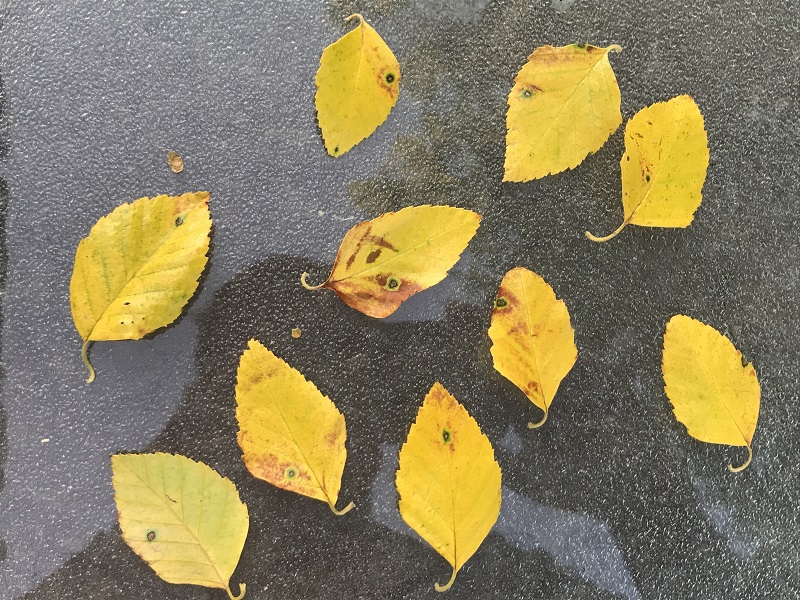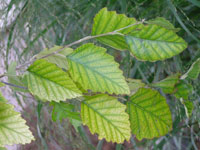Are Your Trees Trying to Tell you Something?


Yellow leaves with green veins? Your tree is telling you it has a nutritional problem.
This droughty summer is starting to show its toll on more than just your water bill. The plants themselves are telling you — you just need to know how to read the leaves.
There are all sorts of miscellaneous reasons leaves appear other than normal. Sometimes many factors all at once. Disease, insects, weather, pesticide, are just a few.
And just like different languages are spoken in different parts of the world, different species may indicate different issues with similar outward appearances. You just need to be able to translate what they are trying to tell you.
Let’s start with the easiest one. Your tree is dropping leaves already. And maybe it started doing this during those 12 long weeks of the drought. The tree is just cutting its losses. Just like when that college kid says they are moving back home for a couple months, then another one does, and the other one does, the household budget has to give, and it is time to move out.
Same with trees. Trees put on leaves in spring using the stored energy reserves they gathered the season before. A good growing year with adequate moisture, and the tree’s energy budget says, go ahead! Let’s put on a show with all those solar panels (leaves), we have energy to burn. Well that is until in the normally wet months of spring, Mother Nature shuts off the water, for months. The tree needs to cut its losses.
Sure, the leaves are great solar panels, but they also transpire (breathe). South Dakota State University indicated that each leaf could lose up to one-tenth of an ounce of water per day in the summer. That would mean a mature tree that could lose 100 gallons of water in a single day. No water? It’s time to go. So perfectly green, healthy leaves might start to be cast off early as a way to reduce water loss.
Nothing is really wrong; it is nature preserving itself. Yes, we can water, as I addressed in an earlier column, but with extended drought, and the size of the root mass of a mature tree, it is like trying to fill the ocean with a thimble.
Then there are the leaves that can give mixed messages. Let’s take River Birch (Betula nigra). You don’t have to be a horticulturalist to figure one leaf clue. It is right there, in the name – does it say “drought birch?” “Clay subsoil, run over by a semi 20 times birch?” No, it says river birch.
So this beautiful, delicate, yet giant tree can have leaves that turn yellow, and I am not talking about the fall, but right now. What is the problem? You guessed it, no water. These trees do well in wet situations. Right plant, right place. But with our fickle Midwest weather, the right place at planting, might end up the wrong place when we have not only a summer drought, but a dry winter prior.
When people ask about their yellowing birch leaves, I immediately follow up with another question. Are they completely yellow? Or are they yellow, but the veins of the leaves a bright green? This is that mixed message I was telling you about. Leaves that are yellowing but have green veins are telling you they have a nutrient deficiency.
The plant disease chlorosis is a nutrient deficiency. But here is where it gets interesting, and a little confusing. Most of the chlorotic trees we see in Will County show iron chlorosis. Pin oaks (native to acidic, well-drained soils) are the number one, along with other red oaks. So is the answer to apply iron? Actually no. We typically have plenty of iron in our soils; it is just bound up by our high pH. pH measure how acidic (sour/low) or alkaline (sweet/high) our soils are. And since Will County (except for a few select pockets) is full of limestone, our soils have a high pH.
The long-term solution is to lower the pH in the area of the tree’s root system by adding elemental sulfur, thereby freeing the iron to be absorbed by the root system. Other recommendations like foliar (leaf) sprays of iron are very short term and doesn’t get to the root of the problem (pun intended).
But seeing those green veins does not always indicate an iron issue. Remember, I said for red maples, chlorotic green veins are indicative of another nutrient issue: manganese. The solution is the same though. By acidifying the soil under red maples, it frees the manganese to be absorbed.
Typically, these treatments last about two years, and then symptoms appear again. Don’t ignore what the leaves are trying to tell you, though. Left untreated, chlorosis can progress. You will start to see speckled brown of the leaves, the leaves getting smaller, branch death and eventually the loss of the tree.
Reading leaves can be a lifesaver!